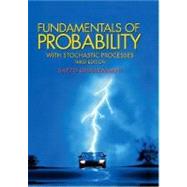
| (Note:Each chapter ends with a Review Problems section.) | |
| Axioms of Probability | |
| Combinatorial Methods | |
| Conditional Probability and Independence | |
| Distribution Functions and Discrete Random Variables | |
| Special Discrete Distributions | |
| Continuous Random Variables | |
| Special Continuous Distributions | |
| Bivariate Distributions | |
| Multivariate Distributions | |
| More Expectations and Variances | |
| Sums of Independent Random Variables and Limit Theorems | |
| Stochastic Processes | |
| Simulation | |
| Appendix Tables | |
| Answers to Odd-Numbered Exercises | |
| Index | |
| Table of Contents provided by Publisher. All Rights Reserved. |
The New copy of this book will include any supplemental materials advertised. Please check the title of the book to determine if it should include any access cards, study guides, lab manuals, CDs, etc.
The Used, Rental and eBook copies of this book are not guaranteed to include any supplemental materials. Typically, only the book itself is included. This is true even if the title states it includes any access cards, study guides, lab manuals, CDs, etc.